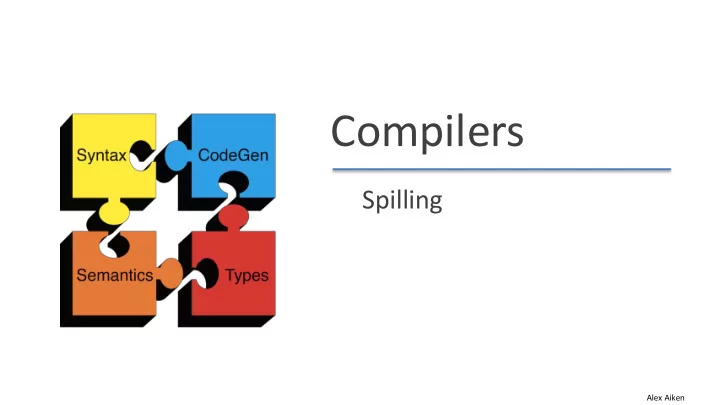

Compilers Spilling Alex Aiken
Spilling • What happens if the graph coloring heuristic fails to find a coloring? • In this case, we can’t hold all values in registers. – Some values are spilled to memory Alex Aiken
Spilling • What if all nodes have k or more neighbors? • Example: Try to find a 3-coloring of the RIG: a b f c e d Alex Aiken
Spilling • Remove a and get stuck b f c e d Alex Aiken
Spilling • Pick a node as a candidate for spilling – A spilled value “lives” in memory – Assume f is chosen b f c e d Alex Aiken
Spilling • Remove f and continue the simplification – Simplification now succeeds: b, d, e, c b c e d Alex Aiken
Spilling • Eventually we must assign a color to f • We hope that among the 4 neighbors of f we use less than 3 colors optimistic coloring r 3 b ? f c r 1 r 2 e r 3 d Alex Aiken
Spilling • If optimistic coloring fails, we spill f – Allocate a memory location for f • Typically in the current stack frame • Call this address fa • Before each operation that reads f, insert f := load fa • After each operation that writes f, insert store f, fa Alex Aiken
Spilling Original code a := b + c d := -a e := d + f b := d + e f := 2 * e e := e - 1 b := f + c Alex Aiken
Spilling a := b + c d := -a The code after spilling f f1 := load fa e := d + f1 f2 := 2 * e b := d + e e := e - 1 store f2, fa f3 := load fa b := f3 + c Alex Aiken
Recompute liveness Spilling a := b + c {a,c,f} d := -a {c,d,f} f1 := load fa {b,c,f} e := d + f1 {c,d,f1} {c,d,e,f} {c,e} f2 := 2 * e b := d + e {c,f2} {b,c,e,f} e := e - 1 store f2, fa {b,c,f} {c,f} {c,f} {b} f3 := load fa {c,f3} b := f3 + c {b} Alex Aiken
Spilling • New liveness information is almost as before – Note f has been split into three temporaries • fi is live only – Between a fi := load fa and the next instruction – Between a store fi, fa and the preceding instr. • Spilling reduces the live range of f – And thus reduces its interferences – Which results in fewer RIG neighbors Alex Aiken
Spilling • Some edges of the spilled node are removed • In our case f still interferes only with c and d • And the new RIG is 3-colorable a b f1 f3 c e f2 d Alex Aiken
Spilling • Additional spills might be required before a coloring is found • The tricky part is deciding what to spill – But any choice is correct • Possible heuristics: – Spill temporaries with most conflicts – Spill temporaries with few definitions and uses – Avoid spilling in inner loops Alex Aiken
Spilling For the given code fragment and RIG, find the minimum cost spill. In this example, the cost of spilling a node is given by: A := 1 # of occurrences (use or definition) – # of conflicts B := A * 2 + 5 if the node corresponds to a variable used in a loop C := C - B A := B + 1 A A < 16 A B B C C D D := C + 1 D
Spilling • Register allocation is a “must have” in compilers: – Because intermediate code uses too many temporaries – Because it makes a big difference in performance • Register allocation is more complicated for CISC machines Alex Aiken
Recommend
More recommend